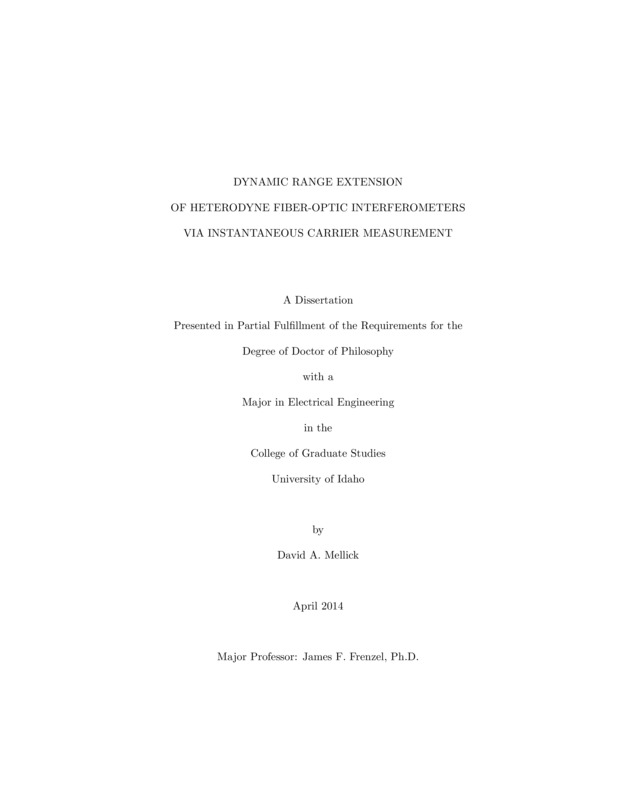Dynamic Range Extension of Heterodyne Fiber-Optic Interferometers Via Instantaneous Carrier Measurement
Mellick, David Allen. (2014). Dynamic Range Extension of Heterodyne Fiber-Optic Interferometers Via Instantaneous Carrier Measurement. Theses and Dissertations Collection, University of Idaho Library Digital Collections. https://www.lib.uidaho.edu/digital/etd/items/mellick_idaho_0089d_10046.html
- Title:
- Dynamic Range Extension of Heterodyne Fiber-Optic Interferometers Via Instantaneous Carrier Measurement
- Author:
- Mellick, David Allen
- Date:
- 2014
- Keywords:
- Demodulation Dynamic Range Fiber-Optic Sensors Frequency Discrimination Interferometers
- Program:
- Electrical and Computer Engineering
- Subject Category:
- Electrical engineering
- Abstract:
-
Fiber-optic sensors are of interest in a wide range of fields. In particular, fiber-optic interferometers are ideally suited for acoustic and vibration measurement applications, such as in the oil exploration industry. Primary benefits of fiber-optic sensors include EMI immunity, remote interrogation, and the ability to multiplex hundreds of sensors on a single fiber. However, one issue impacting the adoption of fiber-optic sensing technology is limited dynamic range.
This dissertation presents a novel approach to extending the dynamic range of heterodyne modulated fiber-optic interferometers. By measuring and tracking the instantaneous heterodyne carrier frequency, a correction factor can be obtained to mitigate excession errors of the demodulator, thereby extending the high-end dynamic range.
Of particular importance to the dynamic range extension approach is how the carrier frequency is measured. Three methods of frequency discrimination are presented as part of this work. Two of the methods, DIFM and DFT, are shown to be well suited for the extension technique. DIFM requires substantially fewer hardware resources, but DFT has a small performance advantage.
A MATLAB simulation script was developed to test the theory of this work. Simulations were conducted to test the viability of the individual frequency discrimination methods and the dynamic range extension approach itself. The simulations demonstrated the ability of the approach to provide a more than 20 dB dynamic range extension. The primary limitations of the approach are the available system bandwidth and the hardware resources required to measure that bandwidth.
The theory and simulations presented as part of this dissertation were verified through experimental testing. Both the DIFM and DFT variants of the approach were implemented in a FPGA and tested under real-world conditions. The experimental results closely matched the simulations, and verified both as being capable of providing a reliable dynamic range extension of 20 dB or more.
- Description:
- doctoral, Ph.D., Electrical and Computer Engineering -- University of Idaho - College of Graduate Studies, 2014
- Major Professor:
- Frenzel, James F
- Committee:
- Donohoe, Gregory W; Ay, Suat U; Anderson, Michael J
- Defense Date:
- 2014
- Identifier:
- Mellick_idaho_0089D_10046
- Type:
- Text
- Format Original:
- Format:
- application/pdf
- Rights:
- In Copyright - Educational Use Permitted. For more information, please contact University of Idaho Library Special Collections and Archives Department at libspec@uidaho.edu.
- Standardized Rights:
- http://rightsstatements.org/vocab/InC-EDU/1.0/

